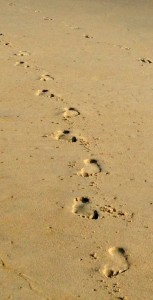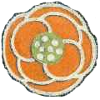I have been turning over a thought I have had since Sunday. I am doing much better at sitting quietly without fidgeting at Mass these days, I am still not good for long periods of time and crowds, but I have a fondness for our very quiet corner in the back pew. I have learned, despite what others may say and write about Mass “participation”, that it is enough that I am there, I am enough for God. He is Father God, a Father whom delights in my imperfect presence.
The Gospel reading was from Mark, the leper that was healed by Christ. The homilist shared that leprosy in ancient times was an all encompassing term for any skin disease and that any sign of skin disease meant exclusion from the community for fear of contamination. I wondered how many people were needlessly excluded and shunned for a simple rash? What that must have felt like to be unjustly excluded from a community that you loved, a community that you lived in, worshipped with, suffered with, the pain of rejection searing. And because having been declared unclean, re-entry into the community was forbidden, so you died in your exclusion.
I thought of the man made clean by Christ and all that it would mean for this one man, freedom to move about as he wished, no longer excluded from his community, the joyful welcome back into the fold – or maybe not. There is a huge difference between being made clean and being accepted as being made clean. There is a huge difference between the freedom to rejoin a community and being welcomed in that freedom. Think about it, the man was a known leper, he was healed, what wonderful news, but you really want him to sit next to you? Might you let your child near him? Allow him to touch your dishes, eat at your table, breathe your air? The water gets pretty muddy pretty quick, it seemed like such a lovely story at first. What did his first rejection feel like? He told his story so often that Jesus could not even enter a town openly, Jesus remained in deserted places but the people still found him in hopes that Jesus would heal them. We aren’t told anymore of the leper’s story after that, but I sense his life did not take him back to his community. Rejected for a disease, rejected for being healed, suspicious that he may still be infectious, where did he go? What did he do? His encounter with Christ not only healed him but radically changed the direction of his life.
So too the bereaved parent. The death of a beloved child is an encounter with Christ, the suffering God, the wounded God, and it is a disfiguring encounter. In many ways to lose a child is to bear the mark of leprosy. We are avoided, people fear our pain, so we hide our wounds and wrap them so they are not visible. But they grow and ooze, they eat away at us when denied light and air. Perhaps fear that child death is contagious, our child and their death is not mentioned, except to be told that our separation is only for a little while, then we will see them again, so be of good cheer and business as usual. Come back when you longer bear the suppurating sore of grief, come back when you can be as you were, come back when you are clean. Where is the leper to be welcomed? Who will sit at his table and share bread?
 I see the leper who was made clean, gazing at his smooth skin, healthy and glowing from the sun. He looks to the walls of the magnificent temple, a place where he is now received, he smiles wistfully and lifts his pack full of provisions and makes his way towards his former colony to bring food and soothing unguents for his people still suffering. Does he become a healer of sorts, remembering those who still suffer? Who is his community, who is his tribe? Having literally been touched by the hand of God, he finds the rigid walls of his community stifling, he has a story to tell, and a heart for healing. He shifts his pack to his other shoulder, still marveling at the healed flesh, sun warmed muscles are eager to stretch, his feet unbound, he sets off on his journey.
I see the leper who was made clean, gazing at his smooth skin, healthy and glowing from the sun. He looks to the walls of the magnificent temple, a place where he is now received, he smiles wistfully and lifts his pack full of provisions and makes his way towards his former colony to bring food and soothing unguents for his people still suffering. Does he become a healer of sorts, remembering those who still suffer? Who is his community, who is his tribe? Having literally been touched by the hand of God, he finds the rigid walls of his community stifling, he has a story to tell, and a heart for healing. He shifts his pack to his other shoulder, still marveling at the healed flesh, sun warmed muscles are eager to stretch, his feet unbound, he sets off on his journey.
